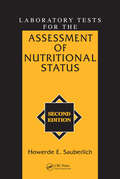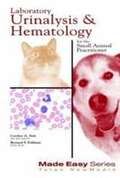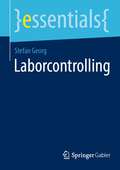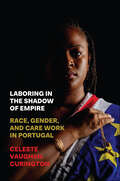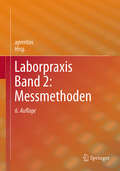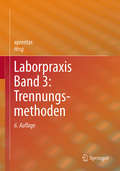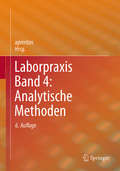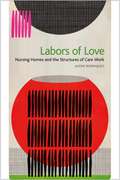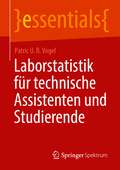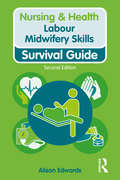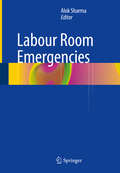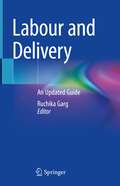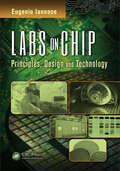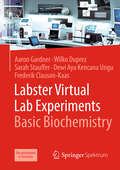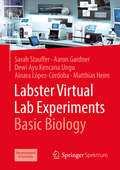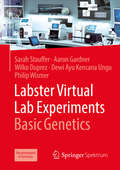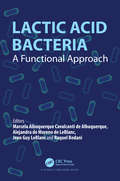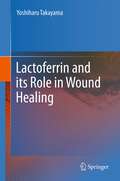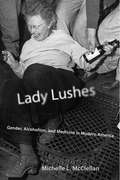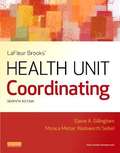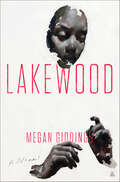- Table View
- List View
Laboratory Tests for the Assessment of Nutritional Status (Modern Nutrition Ser. #21)
by Howerde E. SauberlichProper nutrition is the single most important component of preventative health care. Heart disease, diabetes, and other ailments are all linked to dietary habits. Accurate nutritional assessment can be a matter of life or death. Laboratory Tests for the Assessment of Nutritional Status explores the expanded number of nutrients that can now be evaluated. The author makes a compelling case for the practice and advancement of this critical health care tool. Nutritional assessment identifies undernutrition, overnutrition, specific nutrition deficiencies, and imbalances. Diligent assessment determines the appropriate nutrition intervention and monitors its effects. This book is a total revision of the 1974 version of the same title co -authored by Sauberlich. Since then, remarkable progress has been made on the methodologies applicable to nutrition status assessment and to the expanded number of nutrients that can be evaluated, especially trace elements. The introduction of high-performance liquid chromatography, amperometric detectors, and other technologies has advanced nutritional assessment by leaps and bounds. Today, nutritionists can gauge the value of microminerals, trace elements, and ultratrace elements. Sauberlich's revision updates the reader to the latest and most important trends in nutrition. These laboratory methods for the assessment of nutritional status are vital for identifying individuals as well as populations with nutritional risks.
Laboratory Urinalysis and Hematology for the Small Animal Practitioner
by Carolyn Sink Bernard FeldmanThe main goal of this book is to provide an easily readable and accessible guide which we hope will be readily found on the laboratory bench and will be constantly open and used.
Laborcontrolling (essentials)
by Stefan GeorgUnternehmen wollen und müssen Geld verdienen. Zur Erreichung dieses Ziels muss jede Fachabteilung beitragen – auch das Labor. Gerade in Laboren arbeiten viele Fachkräfte ohne kaufmännische Erfahrung. An diese richtet sich das Buch.Lernen Sie die wichtigen Grundlagen des Rechnungswesens kennen, auf Basis derer Gewinne und Rentabilitäten bestimmt werden. Auch typische kostenrechnerische Werkzeuge wie der Betriebsabrechnungsbogen oder die Deckungsbeitragsrechnung werden thematisiert. Erfahren Sie, wie Sie Kennzahlen zur Unternehmenssteuerung richtig einsetzen können, was Sie dabei beachten müssen und welche laborspezifischen Kennzahlen es gibt. Und machen Sie sich ein Bild davon, wie Sie mit einer Balanced Scorecard das Labor (und das gesamte Unternehmen) zielgerichtet steuern können.Alle dargestellten betriebswirtschaftlichen Methoden sind grundlegend beschrieben und auf die Besonderheiten des Labors übertragen.
Laboring in the Shadow of Empire: Race, Gender, and Care Work in Portugal (Inequality at Work: Perspectives on Race, Gender, Class, and Labor)
by Celeste Vaughan CuringtonLaboring in the Shadow of Empire: Race, Gender, and Care Work in Portugal examines the everyday lives of an African-descendant care service workforce that labors in an ostensibly “anti-racial” Europe and against the backdrop of the Portuguese colonial empire. While much of the literature on global care work has focused on Asian and Latine migrant care workers, there is comparatively less research that explicitly examines African care workers and their migration histories to Europe. Sociologist Celeste Vaughan Curington focuses on Portugal—a European setting with comparatively liberal policies around family settlement and naturalization for migrants. In this setting, rapid urbanization in the late twentieth century, along with a national push to reconcile work and family, has shaped the growth of paid home care and cleaning service industries. Many researchers focus on informal work settings, where immigrant rights are restricted and many workers are undocumented or without permanent residence status. Curington instead examines workers who have accessed citizenship or permanent residence status and also explores African women’s experiences laboring in care and service industries in the formal market, revealing how deeply colonial and intersectional logics of a racialized and international division of reproductive labor in Portugal render these women “hyper-invisible” and “hyper-visible” as “appropriate” workers in Lisbon.
Laborpraxis Band 1: Einführung, Allgemeine Methoden
by AprentasDas vierbändige Standardwerk für die grundlegende praktische Arbeit im chemisch-pharmazeutischen Labor mit Schwerpunkt Synthesemethoden, Chromatographie und Spektroskopie liegt jetzt in der 6. völlig neu überarbeiteten Auflage vor. Es dient Berufseinsteigern als breit angelegtes Lehrmittel und erfahrenen Fachkräften als Nachschlagewerk mit übersichtlich dargestellten theoretischen Grundlagen und konkreten, erprobten Anwendungsideen. Die theoretischen Grundlagen für jedes Kapitel sind gut lesbar abgefasst und unterstützen das Verständnis für praktische Arbeiten und Gerätefunktionen. Zu jedem Kapitel gibt es Hinweise auf vertiefende und weiterführende Literatur. Arbeitssicherheit und –hygiene sowie die zwölf Prinzipien der nachhaltigen Chemie finden neben den entsprechenden Kapiteln Beachtung. Die im Buch erwähnten praktischen Grundlagen gründen auf Gegebenheiten in der chemisch-pharmazeutischen Industrie in der Schweiz. Sie finden im gesamten deutschsprachigen Raum Anwendung, auch in verwandten Arbeitsgebieten wie biochemischen, klinischen, werkstoffkundlichen oder universitären Laboratorien. Die Laborpraxis eignet sich für den Einsatz in der Grund- und in der Weiterbildung von Fachpersonal. Der Inhalt entspricht den aktuellen Anforderungen der Bildungsverordnung und des Bildungsplanes zum Beruf Laborantin / Laborant mit eidgenössischem Fähigkeitszeugnis (EFZ), welche vom Staatssekretariat für Bildung, Forschung und Innovation (SBFI) in Bern verordnet wurden. Damit steht den Lernenden eine gute Grundlage für die Vorbereitung auf das Qualifikationsverfahren (QV) zur Verfügung; Expertinnen und Experten stützen ihre persönlichen Vorbereitungsarbeiten und ihre fachlichen Beurteilungen auf dieses Buch. Band 1 und Band 2 behandeln ausführlich die Grundlagen der Laborarbeit und ausgewählte Messtechniken. Band 3 ist auf präparative und analytische Trennungsmethoden, Band 4 auf nasschemische und spektroskopische Analysemethoden fokussiert. Sowohl konventionelle Methoden als auch modernste Techniken finden Erwähnung. Der Fokus auf beständig gültigen Prinzipien erlaubt auch neue, nicht erwähnte Techniktrends zu verstehen sowie die tägliche Arbeit im chemisch-pharmazeutischen Labor zu reflektieren.
Laborpraxis Band 2: Messmethoden
by AprentasDas vierbändige Standardwerk für die grundlegende praktische Arbeit im chemisch-pharmazeutischen Labor mit Schwerpunkt Synthesemethoden, Chromatographie und Spektroskopie liegt jetzt in der 6. völlig neu überarbeiteten Auflage vor. Es dient Berufseinsteigern als breit angelegtes Lehrmittel und erfahrenen Fachkräften als Nachschlagewerk mit übersichtlich dargestellten theoretischen Grundlagen und konkreten, erprobten Anwendungsideen. Die theoretischen Grundlagen für jedes Kapitel sind gut lesbar abgefasst und unterstützen das Verständnis für praktische Arbeiten und Gerätefunktionen. Zu jedem Kapitel gibt es Hinweise auf vertiefende und weiterführende Literatur. Arbeitssicherheit und –hygiene sowie die zwölf Prinzipien der nachhaltigen Chemie finden neben den entsprechenden Kapiteln Beachtung. Die im Buch erwähnten praktischen Grundlagen gründen auf Gegebenheiten in der chemisch-pharmazeutischen Industrie in der Schweiz. Sie finden im gesamten deutschsprachigen Raum Anwendung, auch in verwandten Arbeitsgebieten wie biochemischen, klinischen, werkstoffkundlichen oder universitären Laboratorien. Die Laborpraxis eignet sich für den Einsatz in der Grund- und in der Weiterbildung von Fachpersonal. Der Inhalt entspricht den aktuellen Anforderungen der Bildungsverordnung und des Bildungsplanes zum Beruf Laborantin / Laborant mit eidgenössischem Fähigkeitszeugnis (EFZ), welche vom Staatssekretariat für Bildung, Forschung und Innovation (SBFI) in Bern verordnet wurden. Damit steht den Lernenden eine gute Grundlage für die Vorbereitung auf das Qualifikationsverfahren (QV) zur Verfügung; Expertinnen und Experten stützen ihre persönlichen Vorbereitungsarbeiten und ihre fachlichen Beurteilungen auf dieses Buch. Band 1 und Band 2 behandeln ausführlich die Grundlagen der Laborarbeit und ausgewählte Messtechniken. Band 3 ist auf präparative und analytische Trennungsmethoden, Band 4 auf nasschemische und spektroskopische Analysemethoden fokussiert. Sowohl konventionelle Methoden als auch modernste Techniken finden Erwähnung. Der Fokus auf beständig gültigen Prinzipien erlaubt auch neue, nicht erwähnte Techniktrends zu verstehen sowie die tägliche Arbeit im chemisch-pharmazeutischen Labor zu reflektieren.
Laborpraxis Band 3: Trennungsmethoden
by AprentasDas vierbändige Standardwerk für die grundlegende praktische Arbeit im chemisch-pharmazeutischen Labor mit Schwerpunkt Synthesemethoden, Chromatographie und Spektroskopie liegt jetzt in der 6. völlig neu überarbeiteten Auflage vor. Es dient Berufseinsteigern als breit angelegtes Lehrmittel und erfahrenen Fachkräften als Nachschlagewerk mit übersichtlich dargestellten theoretischen Grundlagen und konkreten, erprobten Anwendungsideen. Die theoretischen Grundlagen für jedes Kapitel sind gut lesbar abgefasst und unterstützen das Verständnis für praktische Arbeiten und Gerätefunktionen. Zu jedem Kapitel gibt es Hinweise auf vertiefende und weiterführende Literatur. Arbeitssicherheit und –hygiene sowie die zwölf Prinzipien der nachhaltigen Chemie finden neben den entsprechenden Kapiteln Beachtung. Die im Buch erwähnten praktischen Grundlagen gründen auf Gegebenheiten in der chemisch-pharmazeutischen Industrie in der Schweiz. Sie finden im gesamten deutschsprachigen Raum Anwendung, auch in verwandten Arbeitsgebieten wie biochemischen, klinischen, werkstoffkundlichen oder universitären Laboratorien.Die Laborpraxis eignet sich für den Einsatz in der Grund- und in der Weiterbildung von Fachpersonal. Der Inhalt entspricht den aktuellen Anforderungen der Bildungsverordnung und des Bildungsplanes zum Beruf Laborantin / Laborant mit eidgenössischem Fähigkeitszeugnis (EFZ), welche vom Staatssekretariat für Bildung, Forschung und Innovation (SBFI) in Bern verordnet wurden. Damit steht den Lernenden eine gute Grundlage für die Vorbereitung auf das Qualifikationsverfahren (QV) zur Verfügung; Expertinnen und Experten stützen ihre persönlichen Vorbereitungsarbeiten und ihre fachlichen Beurteilungen auf dieses Buch. Band 1 und Band 2 behandeln ausführlich die Grundlagen der Laborarbeit und ausgewählte Messtechniken. Band 3 ist auf präparative und analytische Trennungsmethoden, Band 4 auf nasschemische und spektroskopische Analysemethoden fokussiert. Sowohl konventionelle Methoden als auch modernste Techniken finden Erwähnung. Der Fokus auf beständig gültigen Prinzipien erlaubt auch neue, nicht erwähnte Techniktrends zu verstehen sowie die tägliche Arbeit im chemisch-pharmazeutischen Labor zu reflektieren.
Laborpraxis Band 4: Analytische Methoden
by AprentasDas vierbändige Standardwerk für die grundlegende praktische Arbeit im chemisch-pharmazeutischen Labor mit Schwerpunkt Synthesemethoden, Chromatographie und Spektroskopie liegt jetzt in der 6. völlig neu überarbeiteten Auflage vor. Es dient Berufseinsteigern als breit angelegtes Lehrmittel und erfahrenen Fachkräften als Nachschlagewerk mit übersichtlich dargestellten theoretischen Grundlagen und konkreten, erprobten Anwendungsideen. Die theoretischen Grundlagen für jedes Kapitel sind gut lesbar abgefasst und unterstützen das Verständnis für praktische Arbeiten und Gerätefunktionen. Zu jedem Kapitel gibt es Hinweise auf vertiefende und weiterführende Literatur. Arbeitssicherheit und –hygiene sowie die zwölf Prinzipien der nachhaltigen Chemie finden neben den entsprechenden Kapiteln Beachtung. Die im Buch erwähnten praktischen Grundlagen gründen auf Gegebenheiten in der chemisch-pharmazeutischen Industrie in der Schweiz. Sie finden im gesamten deutschsprachigen Raum Anwendung, auch in verwandten Arbeitsgebieten wie biochemischen, klinischen, werkstoffkundlichen oder universitären Laboratorien. Die Laborpraxis eignet sich für den Einsatz in der Grund- und in der Weiterbildung von Fachpersonal. Der Inhalt entspricht den aktuellen Anforderungen der Bildungsverordnung und des Bildungsplanes zum Beruf Laborantin / Laborant mit eidgenössischem Fähigkeitszeugnis (EFZ), welche vom Staatssekretariat für Bildung, Forschung und Innovation (SBFI) in Bern verordnet wurden. Damit steht den Lernenden eine gute Grundlage für die Vorbereitung auf das Qualifikationsverfahren (QV) zur Verfügung; Expertinnen und Experten stützen ihre persönlichen Vorbereitungsarbeiten und ihre fachlichen Beurteilungen auf dieses Buch. Band 1 und Band 2 behandeln ausführlich die Grundlagen der Laborarbeit und ausgewählte Messtechniken. Band 3 ist auf präparative und analytische Trennungsmethoden, Band 4 auf nasschemische und spektroskopische Analysemethoden fokussiert. Sowohl konventionelle Methoden als auch modernste Techniken finden Erwähnung. Der Fokus auf beständig gültigen Prinzipien erlaubt auch neue, nicht erwähnte Techniktrends zu verstehen sowie die tägliche Arbeit im chemisch-pharmazeutischen Labor zu reflektieren.
Labors of Love: Nursing Homes and the Structures of Care Work
by Jason RodriquezEvery day for the next twenty years, more than 10,000 people in the United States will turn 65. With life expectancies increasing as well, many of these Americans will eventually require round-the-clock attention—and we have only begun to prepare for the challenge of caring for them. In Labors of Love, Jason Rodriquez examines the world of the fast-growing elder care industry, providing a nuanced and balanced portrait of the day-to-day lives of the people and organizations that devote their time to supporting America’s aging population. Through extensive ethnographic research, interviews with staff and management, and analysis of internal documents, Rodriquez explores the inner workings of two different nursing homes—one for-profit and one non-profit—to understand the connections among the administrative regulations, the professional requirements, and the type of care provided in both types of facilities. He reveals a variety of challenges that nursing home care workers face day to day: battles over the budget; the administrative hurdles of Medicaid and Medicare; the employees’ struggle to balance financial stability and compassionate care for residents. Yet, Rodriquez argues, nursing home workers give meaning and dignity to their work by building emotional attachments to residents and their care. An unprecedented study, Labors of Love brings new insight into the underlying structures of a crucial and expanding sector of the American health care system.
Laborstatistik für technische Assistenten und Studierende (essentials)
by Patric U. VogelIn diesem essential wird die Anwendung von statistischen Analysen von normalverteilten Daten im Laboralltag dargestellt. Hierzu zählen die Berechnung von Mittelwert und Standardabweichung sowie die Erstellung von einfachen grafischen Abbildungen. Im Anschluss werden Tests auf Ausreißer und Normalverteilung sowie Stichprobenberechnungen anhand einfacher Beispiele vorgestellt. Abschließend erlernen die Leser*innen den Vergleich von Datengruppen mittels t-test und ANOVA, das Erkennen von Zusammenhängen mittels linearer Regression und Korrelation sowie die Anwendung von Konfidenzintervallen. Zusätzlich werden übliche Fehlerquellen bei der Anwendung statistischer Methoden erklärt.
Labour Midwifery Skills: Survival Guide (Nursing and Health Survival Guides)
by Alison EdwardsThis pocket-sized book, presented in an easy-to-follow format, is designed as a tool for students and professionals to carry in any setting, providing a quick reference guide to supporting women during labour. Used as a platform for wider reading, this text is an ideal reference point for any student or professional involved with the care of childbearing women.
Labour Room Emergencies
by Alok SharmaDeveloped by a panel of leading experts in the field of obstetrics, this book provides an overview of disease presentation, treatment, protocols and outcomes in the field of obstetrics. This exhaustive compilation is a culmination of a targeted multidisciplinary approach and evidence based management in obstetrics. Up to date and easy to understand, it offers a blend of widely accepted guidelines, practical clinical know-how and the latest advances in the field, covering all the emergencies encountered in the delivery room.
Labour and Delivery: An Updated Guide
by Ruchika GargThe book Labour and delivery:Update discusses protocols for labour management from A to Z in a concise manner and easy to understand language. It covers latest guidelines for breech delivery, management of preterm labour and premature preterm rupture of membranes and labour complications .It revisits instrumental vaginal delivery as many gynecologists and obstetricians lack the skill for forceps and ventouse delivery.This book covers all the latest cochrane reviews,RCOG, NICE ,ACOG guidelines and other studies for managing various labour conditions. It includes all the latest developments and research to keep the readers abreast with the latest evidence-based strategies.The book is a ready revision tool for busy practitioners, postgraduates, undergraduates,midwifes, and for those who want to focus on delivery and labour events.
Labs on Chip: Principles, Design and Technology (Devices, Circuits, and Systems)
by Eugenio IannoneLabs on Chip: Principles, Design and Technology provides a complete reference for the complex field of labs on chip in biotechnology. Merging three main areas— fluid dynamics, monolithic micro- and nanotechnology, and out-of-equilibrium biochemistry—this text integrates coverage of technology issues with strong theoretical explanations of design techniques. Analyzing each subject from basic principles to relevant applications, this book: Describes the biochemical elements required to work on labs on chip Discusses fabrication, microfluidic, and electronic and optical detection techniques Addresses planar technologies, polymer microfabrication, and process scalability to huge volumes Presents a global view of current lab-on-chip research and development Devotes an entire chapter to labs on chip for genetics Summarizing in one source the different technical competencies required, Labs on Chip: Principles, Design and Technology offers valuable guidance for the lab-on-chip design decision-making process, while exploring essential elements of labs on chip useful both to the professional who wants to approach a new field and to the specialist who wants to gain a broader perspective.
Labster Virtual Lab Experiments: Basic Biochemistry
by Sarah Stauffer Aaron Gardner Wilko Duprez Dewi Ayu Kencana Ungu Frederik Clauson-KaasThis textbook helps you to prepare for your next exams and practical courses by combining theory with virtual lab simulations. The “Labster Virtual Lab Experiments” series gives you a unique opportunity to apply your newly acquired knowledge in a learning game that simulates exciting laboratory experiments. Try out different techniques and work with machines that you otherwise wouldn’t have access to.In this book, you’ll learn the fundamental concepts of basic biochemistry focusing on:Ionic and Covalent BondsIntroduction to Biological MacromoleculesCarbohydratesEnzyme KineticsIn each chapter, you’ll be introduced to one virtual lab simulation and a true-to-life challenge. Following a theory section, you’ll be able to play the relevant simulation that includes quiz questions to reinforce your understanding of the covered topics. 3D animations will show you molecular processes not otherwise visible to the human eye.If you have purchased a printed copy of this book, you get free access to five simulations for the duration of six months. If you’re using the e-book version, you can sign up and buy access to the simulations at www.labster.com/springer.If you like this book, try out other topics in this series, including “Basic Biology”, “Basic Genetics”, and “Genetics of Human Diseases”.
Labster Virtual Lab Experiments: Basic Biology
by Matthias Heim Sarah Stauffer Aaron Gardner Dewi Ayu Ungu Ainara López-CórdobaThis textbook helps you to prepare for both your next exams and practical courses by combining theory with virtual lab simulations. With the “Labster Virtual Lab Experiments” book series you have the unique opportunity to apply your newly acquired knowledge in an interactive learning game that simulates common laboratory experiments. Try out different techniques and work with machines that you otherwise wouldn’t have access to.In this volume on “Basic Biology” you will learn how to work in a biological laboratory and the fundamental theoretical concepts of the following topics: Lab SafetyMitosisMeiosisCellular RespirationProtein SynthesisIn each chapter, you will be introduced to the basic knowledge as well as one virtual lab simulation with a true-to-life challenge. Following a theory section, you will be able to play the corresponding simulation. Each simulation includes quiz questions to reinforce your understanding of the covered topics. 3D animations will show you molecular processes not otherwise visible to the human eye.If you have purchased a printed copy of this book, you get free access to five simulations for the duration of six months. If you’re using the e-book version, you can sign up and buy access to the simulations at www.labster.com/springer.If you like this book, try out other topics in this series, including “Basic Genetcis”, “Basic Biochemistry”, and “Genetics of Human Diseases”.
Labster Virtual Lab Experiments: Basic Genetics
by Sarah Stauffer Aaron Gardner Dewi Ayu Ungu Wilko Duprez Philip WismerThis textbook helps you to prepare for both your next exams and practical courses by combining theory with virtual lab simulations. With the “Labster Virtual Lab Experiments” book series you have the unique opportunity to apply your newly acquired knowledge in an interactive learning game that simulates common laboratory experiments. Try out different techniques and work with machines that you otherwise wouldn’t have access to.In this volume on “Basic Genetics” you will learn how to work in a laboratory with genetic background and the fundamental theoretical concepts of the following topics:Mendelian InheritancePolymerase Chain ReactionAnimal GeneticsGene ExpressionGene RegulationIn each chapter, you will be introduced to the basic knowledge as well as one virtual lab simulation with a true-to-life challenge. Following a theory section, you will be able to play the corresponding simulation. Each simulation includes quiz questions to reinforce your understanding of the covered topics. 3D animations will show you molecular processes not otherwise visible to the human eye. If you have purchased a printed copy of this book, you get free access to five simulations for the duration of six months. If you’re using the e-book version, you can sign up and buy access to the simulations at www.labster.com/springer.If you like this book, try out other topics in this series, including “Basic Biology”, “Basic Biochemistry”, and “Genetics of Human Diseases”.
Lacan with the Philosophers
by Ruth RonenClosely examining Jacques Lacan's unique mode of engagement with philosophy, Lacan with the Philosophers sheds new light on the interdisciplinary relations between philosophy and psychoanalysis. While highlighting the philosophies fundamental to the study of Lacan’s psychanalysis, Ruth Ronen reveals how Lacan resisted the straightforward use of these works. Lacan’s use of philosophy actually has a startling effect in not only providing exceptional entries into the philosophical texts (of Aristotle, Descartes, Kant and Hegel), but also in exposing the affinity between philosophy and psychoanalysis around shared concepts (including truth, the unconscious, and desire), and at the same time affirming the irreducible difference between the analyst and the philosopher. Inspired by Lacan’s resistance to philosophy, Ruth Ronen addresses Lacan’s use of philosophy to create a fertile moment of exchange. Straddling the fields of philosophy and psychoanalysis with equal emphasis, Lacan with the Philosophers develops a unique interdisciplinary analysis and offers a new perspective on the body of Lacan’s writings.
Lactic Acid Bacteria: A Functional Approach
by Alejandra de Moreno de LeBlancLactic acid bacteria (LAB) are a diverse group of bacteria that comprise low GC content Gram-positive cocci or rods that produces lactic acid as the major end product of the fermentation process. Bifidobacterium genera may also be considered as a part of the LAB group for possessing some similar phenotypical characteristics despite the higher GC content. The key feature of LAB metabolism is efficient carbohydrate fermentation. This contributes to the production of several microbial metabolites that result in the improvement of flavor and texture of fermented foods, in addition to its positive impact on the human health when LAB is administered as a probiotic. The book deals with advances made in the functionalities of LAB, such as their effect on vitamin D receptor expression, impact on neurodegenerative pathologies, production of B-vitamins for food bio-enrichment, production of bacteriocins to improve gut microbiota dysbiosis, production of metabolites from polyphenols and their effects on human health, effect on reducing the immunoreaction of food allergens, as biological system using time-temperature to improve food safety, and the use of probiotics in animal feed. The book also reviews the use of LAB and probiotic technologies to develop new functional foods and functional pharmaceuticals.
Lactoferrin and its Role in Wound Healing
by Yoshiharu TakayamaLactoferrin is an iron-binding glycoprotein belonging to the transferrin family. It acts as a defense in host animals against microbes and viruses, since it has a broad spectrum of antimicrobial and antiviral activities. Lactoferrin has been shown to regulate the growth and differentiation of many types of cells. The results of recent studies indicate that lactoferrin is a potent regulator of dermal fibroblasts, and promotes cutaneous wound healing. The collagen gel contraction, a model of wound contraction during wound healing process, and migration of human fibroblasts were enhanced by lactoferrin. LRP-1 (LDL Receptor related Protein-1) acts as a signaling receptor for lactoferrin that mediate fibroblast response to lactoferrin by activating ERK/MAPK signaling pathway. In addition, lactoferrin promotes biosynthesis of extracellular matrix (ECM) component such as type-I collagen and hyaluronan. Hyaluronan is a major component of ECM in connective tissue and promotes wound healing. The promoting effect of lactoferrin on hyaluronan production was accompanied by promotion of HAS2 (hyaluronan synthase 2) expression. These observations suggest that lactoferrin promotes the wound healing by providing an ECM that promotes fibroblast migration. Lactoferrin is also known for its anti-inflammatory and immune modulating properties. According to recent in vivo study, lactoferrin promotes wound repair by promoting the early inflammatory phase of wound healing. Based on this, recombinant human lactoferrin was subsequently tested clinically in a Phase II trial in patients with diabetic ulcers and was found to be effective. Lactoferrin should be further evaluated in patients with diabetic and other types of ulcers.
Lady Lushes: Gender, Alcoholism, and Medicine in Modern America
by Michelle L. McClellanAccording to the popular press in the mid twentieth century, American women, in a misguided attempt to act like men in work and leisure, were drinking more. “Lady Lushes” were becoming a widespread social phenomenon. From the glamorous hard-drinking flapper of the 1920s to the disgraced and alcoholic wife and mother played by Lee Remick in the 1962 film “Days of Wine and Roses,” alcohol consumption by American women has been seen as both a prerogative and as a threat to health, happiness, and the social order. In Lady Lushes, medical historian Michelle L. McClellan traces the story of the female alcoholic from the late-nineteenth through the twentieth century. She draws on a range of sources to demonstrate the persistence of the belief that alcohol use is antithetical to an idealized feminine role, particularly one that glorifies motherhood. Lady Lushes offers a fresh perspective on the importance of gender role ideology in the formation of medical knowledge and authority.
Lady of the Keep
by Sharon SchulzeHER BODY WAS GREAT WITH CHILD But her guilt was far greater. For though Lady Moira Fitzgerald had sacrificed herself to keep her people safe, she knew no man would have her now. Certainly not one as noble as Sir Connor FitzClifford! And yet her heart flared with passion whenever he drew near… Sworn to protect Gerald's keep and all within, Connor FitzClifford hadn't realized such a vow would reweave the tapestry of his life. For his promise had bound him not only to the besieged fortress, but also to its mistress, the enigmatic Lady Moira, a woman whose very soul mirrored his own!
Lafleur Brooks' Health Unit Coordinating (Seven Edition)
by Elaine A. Gillingham Monica Wadsworth SeibelGet the most comprehensive, in-depth coverage on health unit coordinating from the industry's most popular text! <P><P>Expert authors Elaine Gillingham and Monica Wadsworth Seibel offer in-depth discussion of key theories and concepts surrounding the profession and guide you through the common responsibilities of a health unit coordinator in both traditional and electronic medical record environments. <P><P>From greeting new patients and dealing with visitors to transcribing physicians' orders, maintaining statistical reports, and preparing patient charts, this text will prepare you for success across all areas of health unit coordination.
Lakeland Nurse: A Sweet Medical Romance (Medical Romances #10)
by Gill Sanderson<p>She had dreams...and he had secrets...<p> <p>Nurse Zanne Ripley was devastated to discover that her application to go to medical school had been unsuccessful- and all because of Dr Neil Calder. He'd taken an instant dislike to her at her interview, and now she had to work side by side with him at the Mountain Activities centre in the Lake District!<p> <p>But his charm soon broke down Zanne's defences, and she knew she was falling in love. But Neil had a secret and devastating plan which could all but destroy Zanne...<p>
Lakewood: A Novel
by Megan GiddingsNPR Book of the Year 2020Electric Literature: One of 55 Books by Women and Nonbinary Writers of Color to Read in 2020 | Lit Hub & The Millions: Most Anticipated Books of 2020 | Ms. Magazine: Anticipated 2020 Feminist Books | Refinery29: Books by Black Women We are Looking Forward To Reading | One of The Millions’ Most Anticipated Reads of 2020 | Amazon Book of the Month Pick | Audible Editor’s Pick | Essence’s Pick| Glamour’s Must Read | Ms. Magazine’s Anticipated Read of 2020 A startling debut about class and race, Lakewood evokes a terrifying world of medical experimentation—part The Handmaid’s Tale, part The Immortal Life of Henrietta Lacks.When Lena Johnson’s beloved grandmother dies, and the full extent of the family debt is revealed, the black millennial drops out of college to support her family and takes a job in the mysterious and remote town of Lakewood, Michigan. On paper, her new job is too good to be true. High paying. No out of pocket medical expenses. A free place to live. All Lena has to do is participate in a secret program—and lie to her friends and family about the research being done in Lakewood. An eye drop that makes brown eyes blue, a medication that could be a cure for dementia, golden pills promised to make all bad thoughts go away.The discoveries made in Lakewood, Lena is told, will change the world—but the consequences for the subjects involved could be devastating. As the truths of the program reveal themselves, Lena learns how much she’s willing to sacrifice for the sake of her family. Provocative and thrilling, Lakewood is a breathtaking novel that takes an unflinching look at the moral dilemmas many working-class families face, and the horror that has been forced on black bodies in the name of science.
